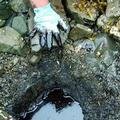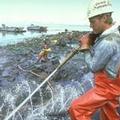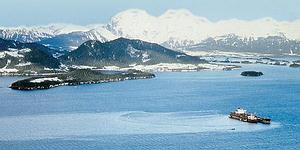 最大漏油案艾克森美孚漏油事件於3月24日屆滿20年,但數千萬美元的賠償費用聯邦政府至今仍未完整收齊。
最大漏油案艾克森美孚漏油事件於3月24日屆滿20年,但數千萬美元的賠償費用聯邦政府至今仍未完整收齊。
這場艾克森美孚漏油事件是環境史上最慘重的災難之一。當時阿拉斯加海岸漏油覆蓋面積達1萬平方英里並沿海岸線漂流長達1300哩,污染及一座國家森林、兩座國家公園、兩座國家野生動物保護區、五座州立公園、四座關鍵棲地、一座州立動物禁獵區及許多阿拉斯加原住民領域。
針對現存威廉王子灣及阿拉斯加灣海灘上浮油恢復工程,聯邦與州政府要求艾克森美孚拿出估計約9200萬美元資金。
 在威廉王子灣存有種在生態與經濟上都相當重要的物種--鯡魚(Pacific herring),目前正處於急迫狀態。在海洋食物鏈裡,鯡魚處有重要地位,他是海洋哺乳類動物、鳥類、無脊椎動物及其他魚類的食物來源,他同時也是經濟魚種作為食物、餌、魚子。威廉王子灣鯡魚漁場自漏油事件後19年中有13年處於封閉,今日仍然持續。
在威廉王子灣存有種在生態與經濟上都相當重要的物種--鯡魚(Pacific herring),目前正處於急迫狀態。在海洋食物鏈裡,鯡魚處有重要地位,他是海洋哺乳類動物、鳥類、無脊椎動物及其他魚類的食物來源,他同時也是經濟魚種作為食物、餌、魚子。威廉王子灣鯡魚漁場自漏油事件後19年中有13年處於封閉,今日仍然持續。
阿拉斯加副檢察長提樂瑞(Craig Tillery)於現況報告的序言中寫到:「過去20年,我們在漏油影響區域內做了許多保育工作的努力,舉凡關鍵棲地永續保育、加強大眾海洋教育且針對這些重要資源發展出更好的管理方式。目前來到威廉王子灣及阿拉斯加北灣的觀光客已看不出漏油事件的跡象,只有美麗的景色與豐富的野生動物。但在某些地區,仍殘有漏油的毒物。某些受傷的物種尚難恢復到未漏油之前狀態。如此長期的傷害是過去前所未料,也是在事件屆滿10年之後也就是1999年,人們才開始正視此問題。當時因漏油事件而受害的主要物種還算少數如鯡魚數量開始減少,但人們都相信大自然會隨時間自癒。至今2009年,20年後的現在許多地區與物種問題卻依舊存在。當人們知道愈多,復育的景象就遠比第一次意識到時更加困難。」
Today is the 20th anniversary of the massive Exxon Valdez oil spill, but the federal and state governments have yet to collect millions of dollars that the oil company agreed to pay.
The Exxon Valdez spill was one of the most worst environmental disasters in history. The spill covered over 10,000 square miles of Alaska coastline. Oil spread along 1,300 miles of shoreline, fouling a national forest, two national parks, two national wildlife refuges, five state parks, four state critical habitat areas, one state game sanctuary, and many ancestral lands for Alaska natives.
The federal and state governments have demanded that Exxon fund restoration projects, estimated at $92 million, based on the continued presence of oil in the habitats of Prince William Sound and Gulf of Alaska beaches.
The most important species that is still experiencing significant problems is Pacific herring, an ecologically and commercially important species in Prince William Sound. They are central to the marine food web, providing food to marine mammals, birds, invertebrates, and other fish. Herring are also commercially fished for food, bait, sac-roe, and spawn on kelp.
Due to the decreased population, the Status Report states, the herring fishery in Prince William Sound has been closed for 13 of the 19 years since the spill and remains closed today.
In his introduction to the Status Report, Alaska Deputy Attorney General Craig Tillery writes, "Over the last 20 years, we have made significant progress in restoration of areas impacted by the spill: permanently protecting crucial habitat; increasing our knowledge of the marine ecosystem; and developing new tools for better management of these vital resources. Visitors to Prince William Sound and the North Gulf Coast of Alaska today again experience spectacular scenery and abundant wildlife and see little evidence of the spill.
Yet the area has not fully recovered. In some areas, ExxonValdez oil still remains and is toxic. Some injured species have yet to recover to pre-spill levels. This long-term damage was not expected at the time of the spill and was only just starting to be recognized in 1999, at the 10th Anniversary. At that time, the majority of species injured by the spill were still struggling with low numbers, such as the depressed herring populations, but it was expected that the ecosystem would recover naturally over time . Now, in 2009, as we reach the end of the second decade, many of these areas and species of concern remain. As we learn more, the picture of recovery is more complicated than was first appreciated."


